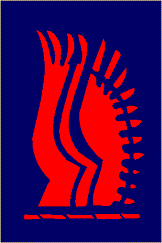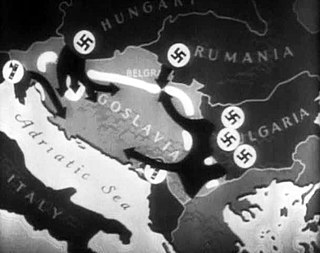Related Research Articles

The Norwegian Army is the land warfare service branch of the Norwegian Armed Forces. The Army is the oldest of the Norwegian service branches, established as a modern military organization under the command of the King of Norway in 1628. The Army participated in various continental wars during the 17th, 18th, and 19th centuries as well, both in Norway and abroad, especially in World War II (1939–1945). It constitutes part of the Norwegian military contribution as a charter member of the North Atlantic Treaty Organization (NATO) since 1949.

The Guards Armoured Division was an armoured division of the British Army during the Second World War. The division was created in the United Kingdom on 17 June 1941 during the Second World War from elements of the Guards units, the Grenadier Guards, Coldstream Guards, Scots Guards, Irish Guards, Welsh Guards, and the Household Cavalry.

The 1st Canadian Division is a joint operational command and control formation based at CFB Kingston, and falls under Canadian Joint Operations Command. It is a high-readiness unit, able to move on very short notice, and is staffed and equipped to meet Canada's military objectives to counter any potential threat.
The German operation for the invasion of Denmark and Norway in April 1940 was code-named Weserübung, or "Weser Exercise." Opposing the invasion were the partially mobilized Norwegian military, and an allied expeditionary force composed of British, French, and Free Polish formations. The following list formed the order of battle for this campaign.

The York and Lancaster Regiment was a line infantry regiment of the British Army that existed from 1881 until 1968. The regiment was created in the Childers Reforms of 1881 by the amalgamation of the 65th Regiment of Foot and the 84th Regiment of Foot. The regiment saw service in many small conflicts and both World War I and World War II until 1968, when the regiment chose to be disbanded rather than amalgamated with another regiment, one of only two infantry regiments in the British Army to do so, with the other being the Cameronians.

The 24th Infantry Brigade was an infantry brigade of the British Army from the First World War. It was reraised during the Second World War, as the 24th Infantry Brigade (Guards). During various designations, the brigade was active throughout the Cold War and existed until 1999, when it was merged with the 5 Airborne Brigade to become 16 Air Assault Brigade.

The 6th Armoured Division was an armoured division of the British Army, created in September 1940 during the Second World War and re-formed in May 1951 in the UK.

The 11th Security Force Assistance Brigade is a brigade of the British Army which is intended to train and assist foreign forces. In 2021, under the Future Army changes, the brigade was redesignated, formerly being the 11th Infantry Brigade & HQ South East. Prior to the Army 2020 changes in 2013, the brigade was temporarily activated for deployment to Afghanistan. Originally formed in the Second Boer War, the brigade was engaged during both World Wars.

The 145th Infantry Brigade was a regional brigade of the British Army that saw active service in both the First and the Second World Wars, disbanding in 1943 and being reformed in the 1990s. The Brigade was renamed Headquarters 11th Infantry Brigade and Headquarters South East in October 2014.

HQ Northern Ireland was the formation responsible for the British Army in and around Northern Ireland. It was established in 1922 and disbanded, replaced by a brigade-level Army Reserve formation, 38 (Irish) Brigade, in 2009.

The Yugoslav order of battle before the invasion of Yugoslavia includes a listing of all operational formations of the Royal Yugoslav Army, Royal Yugoslav Army Air Force and Royal Yugoslav Navy immediately prior to the World War II invasion of that country in April 1941.

The Axis order of battle for the invasion of Yugoslavia was made up of the various operational formations of the German Wehrmacht and Waffen-SS, Italian Armed Forces and Hungarian Armed Forces that participated in the invasion of Yugoslavia during World War II, commencing on 6 April 1941. It involved the German 2nd Army, with elements of the 12th Army and a panzer group combined with overwhelming Luftwaffe support. The eighteen German divisions included five panzer divisions, two motorised infantry divisions and two mountain divisions. The German force also included two well-equipped independent motorised regiments and was supported by over 800 aircraft. The Italian 2nd Army and 9th Army committed a total of 22 divisions, and the Royal Italian Air Force had over 650 aircraft available to support the invasion. The Hungarian 3rd Army also participated, with support from the Royal Hungarian Air Force.

The 2nd Army was a Royal Yugoslav Army formation commanded by Armijski đeneral Dragoslav Miljković that opposed the German-led Axis invasion of the Kingdom of Yugoslavia in April 1941 during World War II. It consisted of three infantry divisions and one horsed cavalry regiment along with supporting units. It formed part of the 2nd Army Group, and was responsible for the defence of the Yugoslav–Hungarian border along the Drava river from Slatina to the Danube.

The 4th Army was a Royal Yugoslav Army formation mobilised prior to the German-led Axis invasion of the Kingdom of Yugoslavia during World War II. It was drawn from the peacetime 4th Army District. When mobilised, it consisted of three divisions, a brigade-strength detachment, one horse cavalry regiment and one independent infantry regiment. It formed part of the 1st Army Group, and was responsible for defending a large section of the Yugoslav–Hungarian border, being deployed behind the Drava river between Varaždin and Slatina. Like all Yugoslav formations at the time, the 4th Army had serious deficiencies in both mobility and firepower.
The 138th Brigade was an infantry brigade of the British Army that saw active service in the First World War with the 46th Division. The brigade again saw active service in the Second World War, with the 46th Infantry Division.

The 148th Infantry Brigade was an infantry brigade formation of the British Army that served in both the First and briefly in the Second World War as part of the 49th Infantry Division and disbanded after the war.
The 40th Infantry Division Slavonska was an infantry formation of the Royal Yugoslav Army that formed part of the 4th Army during the German-led Axis invasion of the Kingdom of Yugoslavia in April 1941. It was partly mobilised from the Osječka military district, and, like all Yugoslav infantry divisions of the time, was a very large and unwieldy formation which was almost entirely reliant on animal transport for mobility. Commanded by Brigadni đeneral Ratko Raketić, it was largely manned by Croat troops, many of whom saw the Germans as potential liberators from Serbian oppression during the interwar period, and the division also lacked modern arms and sufficient ammunition.
The Hampshire Brigade, previously the Portsmouth Brigade and later 128th (Hampshire) Brigade, was an infantry formation of the British Army of the Volunteer Force, Territorial Force (TF) and Territorial Army (TA) in existence from 1889 until after the Second World War. It served in British India during the First World War, but not as a complete formation. During the Second World War, the 128th Infantry Brigade fought in the Tunisia Campaign, in the Italian Campaign, and later in the Greek Civil War. The brigade was composed entirely of battalions from the Hampshire Regiment.

The 1st Cavalry Division of the Royal Yugoslav Army was established in 1921, soon after the creation of the Kingdom of Serbs, Croats and Slovenes, which became the Kingdom of Yugoslavia in 1929. In peacetime it consisted of two cavalry brigade headquarters commanding a total of four regiments. It was part of the Yugoslav 1st Army Group during the German-led World War II Axis invasion of Yugoslavia in April 1941, with a wartime organisation specifying one cavalry brigade headquarters commanding two or three regiments, and divisional-level combat and support units.

The Armistice Army or Vichy French Army was the armed forces of Vichy France permitted under the terms of the Armistice of 22 June 1940. It was officially disbanded in 1942 after the German invasion of the "Free Zone" which was directly ruled by the Vichy regime.
References
- ↑ Hobson, Rolf; Kristiansen, Tom (2001). Norsk Forsvarshistorie[Norwegian Defence History] (in Norwegian). Vol. 3. p. 277. ISBN 9788251406185.
- ↑ Tamelander, Michael; Zetterling, Niklas (2010). Den nionde april[The ninth of April] (in Swedish). Historiska media. pp. 116–117. ISBN 978-9185057955.
- ↑ Tamelander, Michael; Zetterling, Niklas (2010). Den nionde april[The ninth of April] (in Swedish). Historiska media. p. 197. ISBN 978-9185057955.